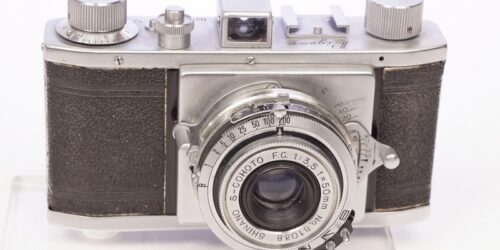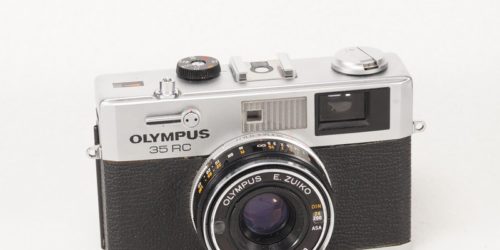Minolta Hi-Matic 11
Minolta Hi-Matic 11
The Minolta Hi-Matic 11 was the last of the Minolta Hi-Matic’ classic’ models, a well-built, solid camera line. However, while the earlier Hi-Matic cameras were straightforward to use, the Hi-Matic 11 is a ‘read the manual first’ model. It could have been a result of advanced, progressive thinking, but the result did not add to this model’s popularity.
To explicate, the first Hi-Matic was a manual mode, no-nonsense camera. It was followed by the 7, 7s, and the 9, which were similar cameras with auto options and lens upgrades. See the complete Hi-Matic line and a page about the Hi-Matic 7s, of which the 11 is based.
I believe the idea behind the Hi-Matic 11 was to offer an easy-to-use camera with fewer controls for the user to fiddle with, and the ability to shoot in all lighting conditions. They did indeed achieve that, but with a confusing camera. Adding insult to injury, the camera front is proudly marked ‘Super 3 Circuit’ and is sometimes offered for sale under this name. The ‘Super 3 Circuit’ name seems to be in line with other Minolta titles of the time, such as the SLS or CLC introduced with the Hi-Matic 7s. There is an online view that the name refers to the three shooting modes, but I would think it hints at the elaborate flash use system.
In this model, Minolta had dropped the EV metering system in favour of a traditional setting, where the camera used a shutter priority auto mode. Furthermore, the intricate flash gun interface is intended to simplify use, but it just adds an extra layer for the user.
At first glance, this model looks similar to the other classic models, with some changes in the lens assembly details. The sizes and weights are on par.
- The top is identical to the 7s and the 9, leaving no doubt about the lineage. It features a lever winder, self-reset frame counter, hot accessory shoe, and fold-up rewind crank.
- The winder lever travels as long as its predecessors, allowing it to be wound in one long stroke or several short passes.
- At the back right shoulder is a slot that shows a red mark once the film is loaded correctly. This is the famed SLS – ‘Safe Loading System’
- The bottom opens via a slider lock on the left.
- The bottom hosts the battery cover. The original battery was a #625 mercury cell, 1.35V, which is no longer available. Alternatives are either the hearing aid zinc air #625, which lasts about a week once activated, or the more expensive #675, which is available online. As a last resort, one could use a smaller 1.5V battery with an adapter, O-ring, and an aluminum foil spacer, or similar.
- Although the battery powers the meter only, the camera will not operate without a battery. To conserve battery power, keep the lens cover on when not in use.
- Inside are the cartridge chamber, a machined film path, dual sprockets to keep the film correctly paced, and a good-sized take-off spool. On the back are a roller to guide the film and a pressure plate.
- The front is where the action is, with some unique – say odd – features.
- The bottom left corner of the front viewer lens appears to be damaged or poorly assembled. Not so, it is a ‘picture in picture’. Henceforth, I will refer to it as PIP.
- The viewer is large and clear, with a live parallax frame but a faint focusing patch.
- In the viewer window, the PIP is at the bottom right corner. It takes practice to use it, and you’ll need to focus either on it or on the viewer. In the viewer, look sharp right with the camera levelled. All it does is focus on the engraving at the front end of the front dial. I have not seen anything similar on another camera brand. I think Minolta had many good intentions, but dropped the ball.
- The settings are on the lens barrel:
- Closest to the body is the focusing dial, marked in meters and feet. A shallow finger rest is at the bottom, guess takes getting used to.
- The next fixed ring features the self-timer fin, marked ‘V’, and the GN selector, which sets the Guide Number for a flash gun. The GN value should be set as marked on the flash gun, either in metric or imperial units. The GN represents the flash gun distance ability. At the opposite side of the GN scale is a chevron marked ‘check, used for battery check.
- From here, it gets complex.
- The meter scale readings are in the viewer, on the right side. See sketch below. Here, Minolta had dropped the EV readings used on previous models towards a civilized aperture scale.
- The side display shows the f-stops marked, from 1.7 at the top to 22 at the bottom. Red zones at the top and bottom indicate under and over exposure, respectively.
- A lightning icon is by the f/11 mark. It is used for battery check and for flash gun use. See the bottom of the diagram below.
- The PIP shows as a bright patch at the bottom right. It trains against the front viewer corner. It displays the value engraved on the front dial, either the shutter speed, a lightning icon when in flash mode, or nothing when in battery check mode.
- At the front dial are:
- To shoot:
- In auto mode, set the front dial red AA mark against the line mark on the fixed front ring. The camera will select the shutter and aperture values. The meter needle will point to the chosen f-value, and, the PIP will display the red ‘A’.
- For shutter priority mode, set the shutter speed on that dial towards the line mark. The camera will select the aperture value. The meter needle will display the selected f-value, and, the PIP will indicate the shutter speed.
- For flashgun use, set the front dial’s lightning icon against the line mark. The camera will select the settings according to the GN selected. The meter needle will point to the lightning mark in the viewer, and, the PIP will show a lightning icon.
- For a battery check, align the green dot on the front dial with the chevron marked ‘check’. The meter needle will point to the lightning icon in the viewer, and, the PIP will show nothing.
For the collector, I doubt if the camera holds any extra value. However, for its bizarre settings, it could grace the Minolta shelf. For a shooter, I would pass. This model is commonly posted for sale at a modest price, although some were sold for over USD 100, I am not sure why.
| Camdex list number | 5324 |
| Brand | Minolta |
| Model | Hi-Matic 11 |
| Manual | Butkus |
| Value | At camdex.ca |
| Format | 35mm |
| Introduced | 1969 |
| AKA | Super 3 Circuit |
| Country | Japan |
| Qty made | |
| Initial price | 25000 |
| Currency | Yen |
| Type | Rangefinder |
| Body material | Metal |
| Mode | Auto, Shutter priority |
| Weight | 710 gr, Body with lens |
| Class average weight | 640 gr, Body with lens |
| ASA range | 25-500 |
| Kit lens | 1,7/45 |
| Lens make | Rokkor |
| Filter size | 55 mm thread or 57 mm slide on. |
| Lens mount | Fixed lens |
| Mount size | N/A |
| Aperture | |
| Shutter | Leaf |
| Shutter make | Seiko ALA |
| Trigger | On top |
| Winder | Lever |
| Shutter cocking | Winder |
| Light meter | CdS, external, coupled |
| Lock | No |
| Speeds | B, 8-500 |
| Mirror | N/A |
| Viewer | Coupled rangefinder |
| DOF preview | No |
| Exposure lock | No |
| Exposure compensation | No |
| Shoe | Hot |
| External sync | Yes |
| Sync speed | 30 |
| Timer | Yes, mechanical |
| Battery, original | Mercury PX625, PX13 |
| Battery, replacement | 625 |
| Battery voltage | 1.35 |
| Integral flash | None |
| Other | |
| More | |
| Service / repair links | See camerlog.com |




















